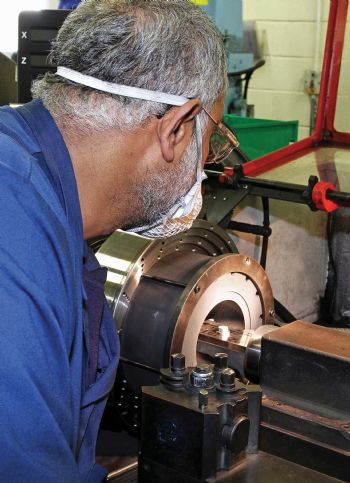
Saint-Gobain Abrasives
(http://www.saint-gobain-abrasives.com) is noted for manufacturing not only grinding wheels but also the diamond roller-dressers and CNC profiling discs that produce wheel profiles and keep them sharp in use. The company’s facility in Staverton, near Cheltenham, for manufacturing dressing products is one of only two diamond roller-dresser production sites in the UK. Recent investments in new plant and equipment, together with the introduction of ‘lean manufacturing’ principles, have resulted in lead times (from order to delivery) that are around one-third shorter than the industry average.
A dresser can be either a profiled diamond roll that plunges rapidly into a wheel for high-volume production applications or a thin disc that traverses over the profile, which is more flexible and more economical for smaller-batch manufacture. There are two types of diamond roller-dresser produced at Staverton — reverse-plated and infiltrated. The latter — usually turned round in a lead time of six weeks (but ‘exceptionally’ within two weeks) — can withstand higher operating temperatures and are tougher, making them more suitable if the inherent profile is weak or if dressing conditions are harsh. CNC dressing discs are also manufactured using the infiltration method.
Reverse-plated roll construction is some-what more time-consuming at eight weeks on average, but it tends to cost a little less. As the dressing roll does not undergo heat distortion, it is preferred where higher accuracy and finer finishes are needed. Optimised solutions Saint-Gobain Abrasives’ customers, many of which are global manufacturers, have the opportunity to engage in engineer-to-engineer conversations when planning their grinding and dressing requirements, thanks to the technical centre at Staverton. In fact, more than 75% of the diamond dressing products manufactured at Staverton are developed in close co-operation with customers.

Saint-Gobain Abrasives’ design team can produce grinding solutions based on a customer’s component drawing or a solid model of the component. The results are tailor-made solutions that perfectly fit the specific requirements of the application or process. This approach is recommended especially if micron tolerances are to be achieved and the grinding cost per part is to be minimised. The company also offers a roll and spindle assembly service. Axial and radial run-out are guaranteed to be within 0.002mm, minimising vibration during dressing and extending the life of the diamond roll. David Balshaw, business development manager, says: “Users can benefit enormously, as the life of a diamond roller-dresser can be increased by as much as 30% by judicious design, careful choice of tolerances and correct assembly.”
Roll production
An infiltrated dressing roll starts life as a circular graphite blank with the grinding-wheel profile turned into the bore. Diamonds are applied to the inner surface prior to the ‘sintering’ process (the mould is filled with powdered metal/metal rods prior to firing). Reverse-plated rolls have a different production route, starting with a turned steel mould. High quality mono-crystalline diamonds are set by hand into areas where dressing will be highly stressed, and the remainder of the profile is covered with randomly distributed diamonds. The roll is placed in an electro-plating tank, and a shell of nickel is built up around the diamonds.

Towards the end of the production process, rolls are internally ground so that the diamond layer is referenced to the bore centre-line to extremely high accuracy. The final stage is lapping the profile of the dressing roll, using diamond tools on a grinder. If a dressing roll or disc has come back for re-lapping, this is the only operation; it results in a product with about the same longevity as the original. In overall charge of the Staverton production centre is plant manager, Mouhcine Berrada, who said: “Manufacturing dressing rolls and profiling discs is no longer a ‘black art’, but it does require a skill set that is rare in the work-place. Experience and knowledge are therefore essential to our day-to-day operations.”
Many applications these days exploit the open-grain characteristics of vitrified grinding wheels such as Saint-Gobain Abrasives’ Norton-branded products — Quantum, Altos, Vortex and Poros 2 — which require lighter dressing, extending the life of the diamond dressing roll or profiling disc. The company recently spent £1.15 million relocating the bonded manufacturing plant in Stafford to new premises at Raleigh Hall in Eccleshall. Since January 2012, the grinding wheels have been manufactured in this new, purpose-built plant, which operates 24hr a day, seven days a week. Production has been streamlined into a more compact footprint, removing unnecessary queuing time and allowing faster throughput and lead times. Extensive use of automation allows a high degree of precision and repeatability to be achieved.